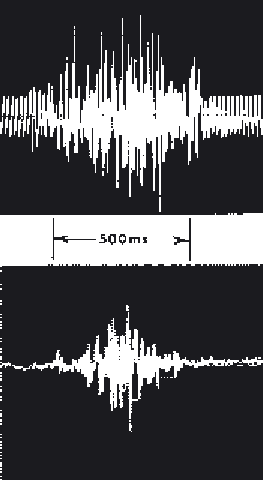Biomedical Engineering Reference
In-Depth Information
(
a
)
(
b
)
Figure 10.11
Storage oscilloscope recordings of an EMG signal. (
a
) With hum
present. (
b
) Without hum.
10.2.5 Cross-Talk in Surface Electromyograms
The detectable pick-up distance was estimated to be about 0.5 cm for small
motor units and about 1.5 cm for the largest units (Fuglevand et al., 1992).
In Figure 10.12, for example, we see a number of surface electrodes over
several thigh muscles in the midthigh region. The range of pick-up is shown
as an arc beneath each electrode. Those m.u.a.p.'s whose fibers are close to
each electrode are not subject to cross-talk; however, there is an overlapping
zone of pick-up where both electrodes detect m.u.a.p.'s from the same active
motor units. This common pick-up is called cross-talk.
Experienced researchers who are knowledgeable about their surface
anatomy chose sites that minimize cross-talk. However, because of close
proximity of the desired muscles, it may be necessary to check that
cross-talk is minimal. The most common way to test for cross-talk is to
conduct a manual resistance test prior to any given experiment. Consider
two adjacent muscles A and B that, during the course of a given movement,
have common periods of activity. The purpose of the manual resistance
tests is to get a contraction on muscle A without any activity on B and vice
versa. Consider electrodes placed on the leg on three muscles that are fairly
close together: tibialis anterior (TA), peroneus longus (PER), and lateral
gastrocnemius (LG). Functionally, the TA is a dorsiflexor and invertor, PER










Search WWH ::

Custom Search